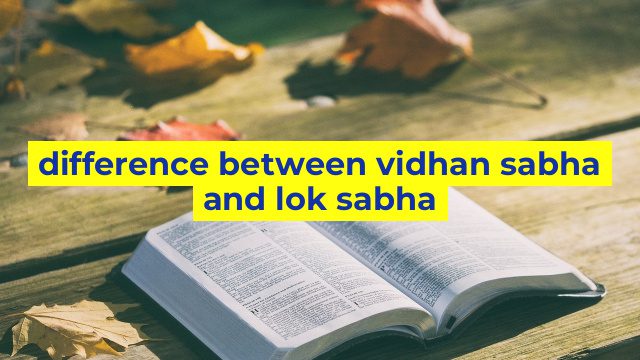The Key Differences Between Vidhan Sabha and Lok Sabha
India is a democratic nation, and its governance is organized within the framework of the Constitution of India. The Indian Parliament is divided into two houses – the Lok Sabha and the Rajya Sabha, while each state in India has its own unicameral legislature, which is known as the Vidhan Sabha or the Legislative Assembly. Although both the Vidhan Sabha and Lok Sabha are designed to represent the Indian people, there are some significant differences between the two. Let’s explore these differences in detail.
Composition
The Lok Sabha, also known as the House of the People, is the lower house of the Indian Parliament. It is directly elected by the people of India and composed of 545 members, out of which 543 are elected and represent individual constituencies, and two are nominated by the President of India to represent the Anglo-Indian community.
The Vidhan Sabha, on the other hand, is a state-level assembly composed of members who are directly elected by the citizens of the state. The total number of members in the Vidhan Sabha varies depending on the population of the state, and each member typically represents a specific geographical constituency.
Role and Responsibilities
The Lok Sabha is the most significant legislative body in India, and its primary role is to represent the people, make laws, and control finances. The Lok Sabha has the power to initiate money bills, and no bill can become law without its approval. The Lok Sabha also has the authority to pass a vote of no confidence against the government, and if such a vote is passed, the government has to resign.
The Vidhan Sabha handles the legislative affairs of a particular state and has the power to make laws on subjects that come under the state list, such as healthcare, agriculture, and education. The Vidhan Sabha also has the power to pass the annual budget for the state and hold the state government accountable for its policies.
Term
Members of the Lok Sabha are elected for a term of five years. However, if the Indian president dissolves the Lok Sabha before its term is up, fresh elections are held to elect new members.
Similarly, members of the Vidhan Sabha are elected for a term of five years, and elections are typically held at intervals of five years or less. The governor of the state has the power to dissolve the Vidhan Sabha before the completion of its term in certain situations.
Conclusion
In summary, while both the Lok Sabha and Vidhan Sabha are democratic institutions that represent the Indian people, they serve different purposes and have distinct roles and responsibilities. The Lok Sabha is responsible for making laws and controlling finances at the national level, while the Vidhan Sabha handles legislative affairs at the state level. Understanding these differences is essential to grasp the functioning and structure of India’s democratic system.
Table difference between vidhan sabha and lok sabha
| Vidhan Sabha | Lok Sabha | |
|---|---|---|
| Composition | The Vidhan Sabha is the state legislative assembly and consists of elected members from the state’s constituencies. | The Lok Sabha is the lower house of the parliament and is composed of members elected through direct elections. |
| Function | The Vidhan Sabha is responsible for making laws related to state subjects, including agriculture, health, education, and other state-specific matters. | The Lok Sabha is responsible for making laws related to national interests, including defence, foreign policy, and other matters related to the nation as a whole. |
| Term | The Vidhan Sabha is elected for a term of five years. | The Lok Sabha is elected for a term of five years, after which elections are held to form a new government. |
| Number of Members | The number of members in the Vidhan Sabha varies from state to state and is based on the population of the state. | The Lok Sabha has a fixed number of 545 members, including two nominated members from the Anglo-Indian community. |
| Speaker | The Vidhan Sabha has a speaker who is responsible for maintaining order and conducting proceedings in the assembly. | The Lok Sabha also has a speaker who is responsible for maintaining order and conducting proceedings in the house. |
| Representation | The Vidhan Sabha represents the people of the state. | The Lok Sabha represents the people of the country. |

